Systems Engineering: Mobile App Project Development Report
VerifiedAdded on 2022/09/27
|7
|1199
|24
Report
AI Summary
This report on Systems Engineering begins by defining the field and contrasting it with the role of Systems Engineers, highlighting its integrative, transdisciplinary nature. It then presents a project scenario for a shopping mall company, XYZ, requiring a mobile app to manage operations and employee activities. The report outlines the project's scope, problem statement, and a detailed overview of the project development phases, including planning, requirements gathering, design, software development using Agile methodology, testing, deployment, and maintenance. It provides a Work Breakdown Structure, project scheduling, and an objective analysis tree. The report concludes with a functional analysis, evaluating the user interface of the developed mobile app, and includes relevant references.
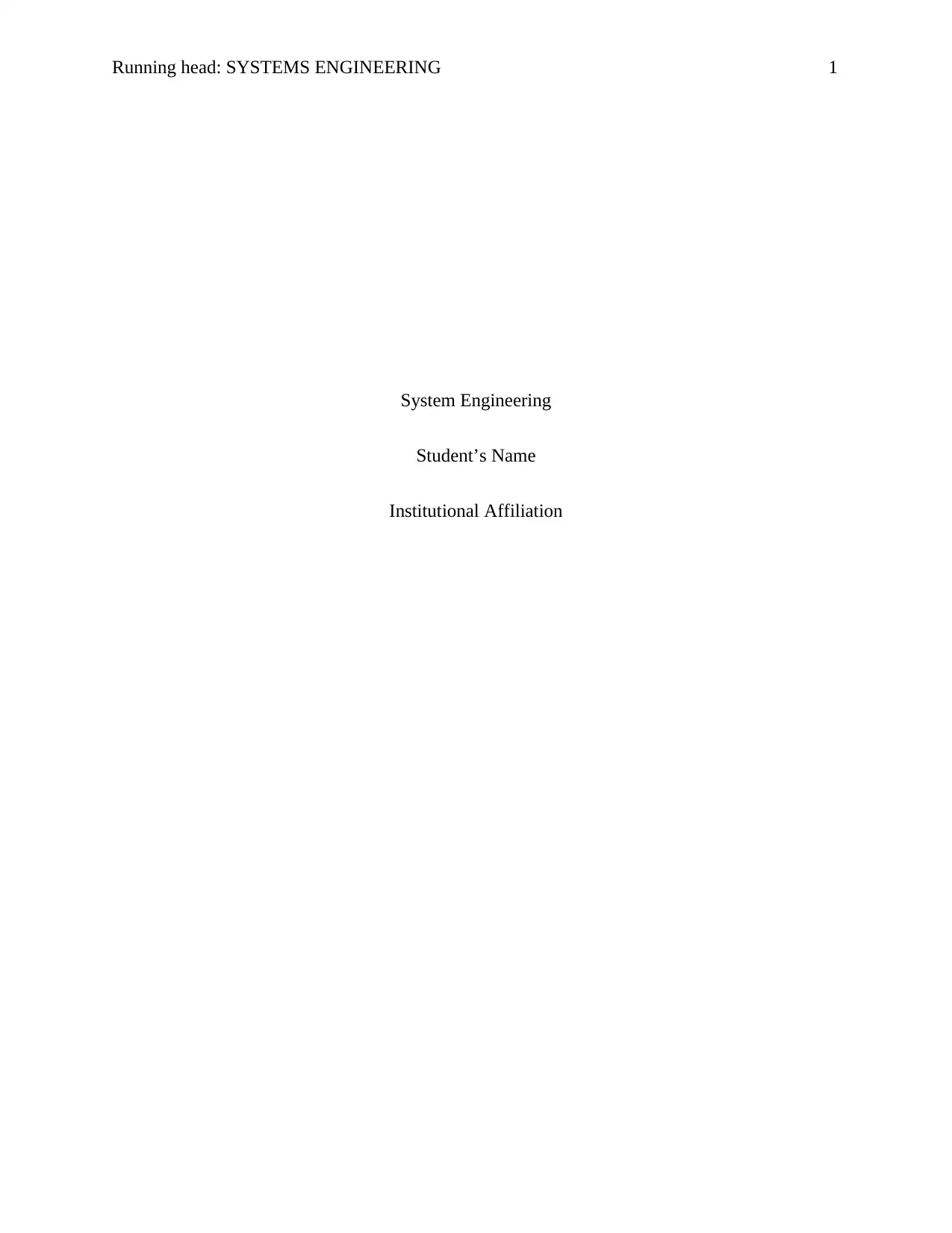
Running head: SYSTEMS ENGINEERING 1
System Engineering
Student’s Name
Institutional Affiliation
System Engineering
Student’s Name
Institutional Affiliation
Paraphrase This Document
Need a fresh take? Get an instant paraphrase of this document with our AI Paraphraser
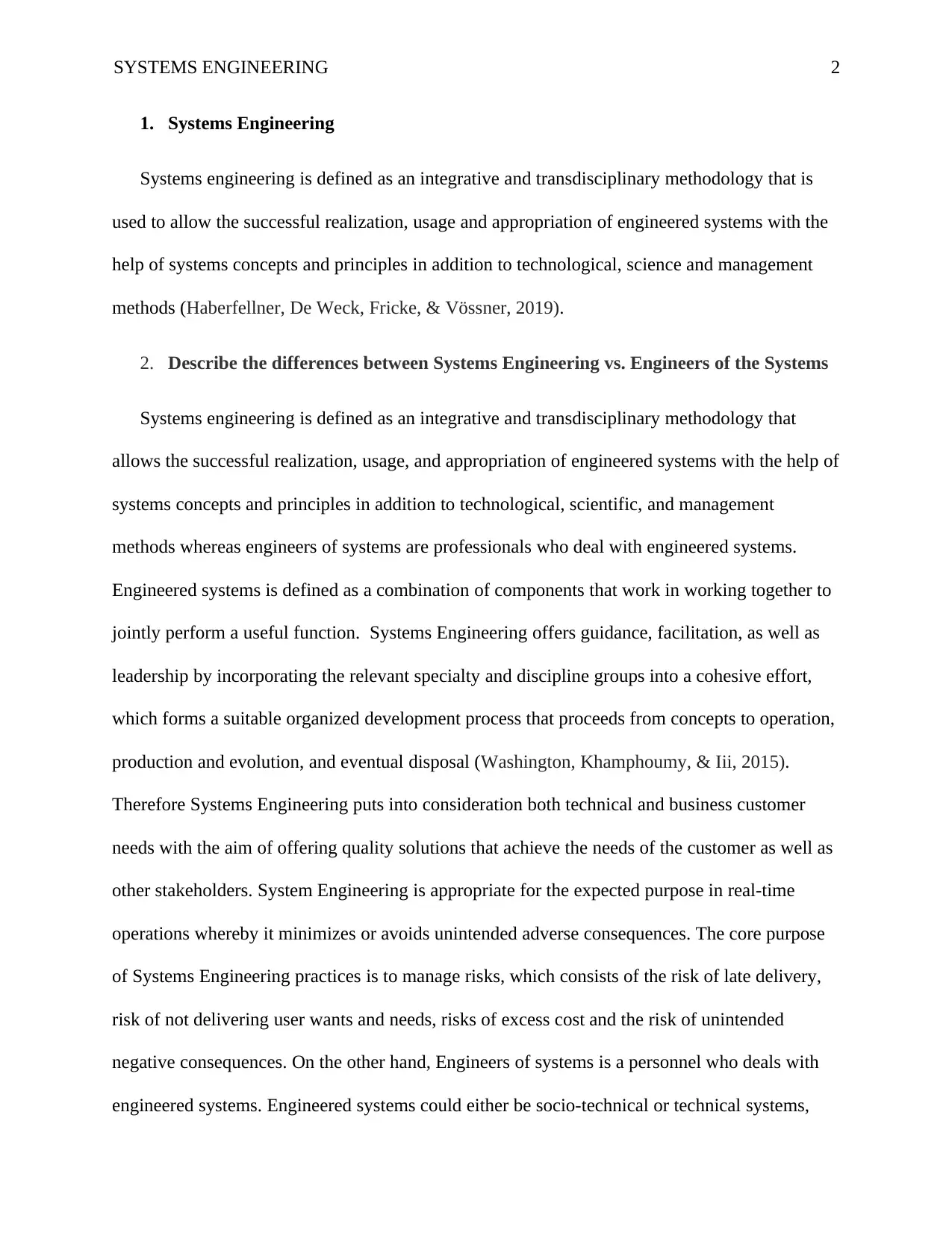
SYSTEMS ENGINEERING 2
1. Systems Engineering
Systems engineering is defined as an integrative and transdisciplinary methodology that is
used to allow the successful realization, usage and appropriation of engineered systems with the
help of systems concepts and principles in addition to technological, science and management
methods (Haberfellner, De Weck, Fricke, & Vössner, 2019).
2. Describe the differences between Systems Engineering vs. Engineers of the Systems
Systems engineering is defined as an integrative and transdisciplinary methodology that
allows the successful realization, usage, and appropriation of engineered systems with the help of
systems concepts and principles in addition to technological, scientific, and management
methods whereas engineers of systems are professionals who deal with engineered systems.
Engineered systems is defined as a combination of components that work in working together to
jointly perform a useful function. Systems Engineering offers guidance, facilitation, as well as
leadership by incorporating the relevant specialty and discipline groups into a cohesive effort,
which forms a suitable organized development process that proceeds from concepts to operation,
production and evolution, and eventual disposal (Washington, Khamphoumy, & Iii, 2015).
Therefore Systems Engineering puts into consideration both technical and business customer
needs with the aim of offering quality solutions that achieve the needs of the customer as well as
other stakeholders. System Engineering is appropriate for the expected purpose in real-time
operations whereby it minimizes or avoids unintended adverse consequences. The core purpose
of Systems Engineering practices is to manage risks, which consists of the risk of late delivery,
risk of not delivering user wants and needs, risks of excess cost and the risk of unintended
negative consequences. On the other hand, Engineers of systems is a personnel who deals with
engineered systems. Engineered systems could either be socio-technical or technical systems,
1. Systems Engineering
Systems engineering is defined as an integrative and transdisciplinary methodology that is
used to allow the successful realization, usage and appropriation of engineered systems with the
help of systems concepts and principles in addition to technological, science and management
methods (Haberfellner, De Weck, Fricke, & Vössner, 2019).
2. Describe the differences between Systems Engineering vs. Engineers of the Systems
Systems engineering is defined as an integrative and transdisciplinary methodology that
allows the successful realization, usage, and appropriation of engineered systems with the help of
systems concepts and principles in addition to technological, scientific, and management
methods whereas engineers of systems are professionals who deal with engineered systems.
Engineered systems is defined as a combination of components that work in working together to
jointly perform a useful function. Systems Engineering offers guidance, facilitation, as well as
leadership by incorporating the relevant specialty and discipline groups into a cohesive effort,
which forms a suitable organized development process that proceeds from concepts to operation,
production and evolution, and eventual disposal (Washington, Khamphoumy, & Iii, 2015).
Therefore Systems Engineering puts into consideration both technical and business customer
needs with the aim of offering quality solutions that achieve the needs of the customer as well as
other stakeholders. System Engineering is appropriate for the expected purpose in real-time
operations whereby it minimizes or avoids unintended adverse consequences. The core purpose
of Systems Engineering practices is to manage risks, which consists of the risk of late delivery,
risk of not delivering user wants and needs, risks of excess cost and the risk of unintended
negative consequences. On the other hand, Engineers of systems is a personnel who deals with
engineered systems. Engineered systems could either be socio-technical or technical systems,
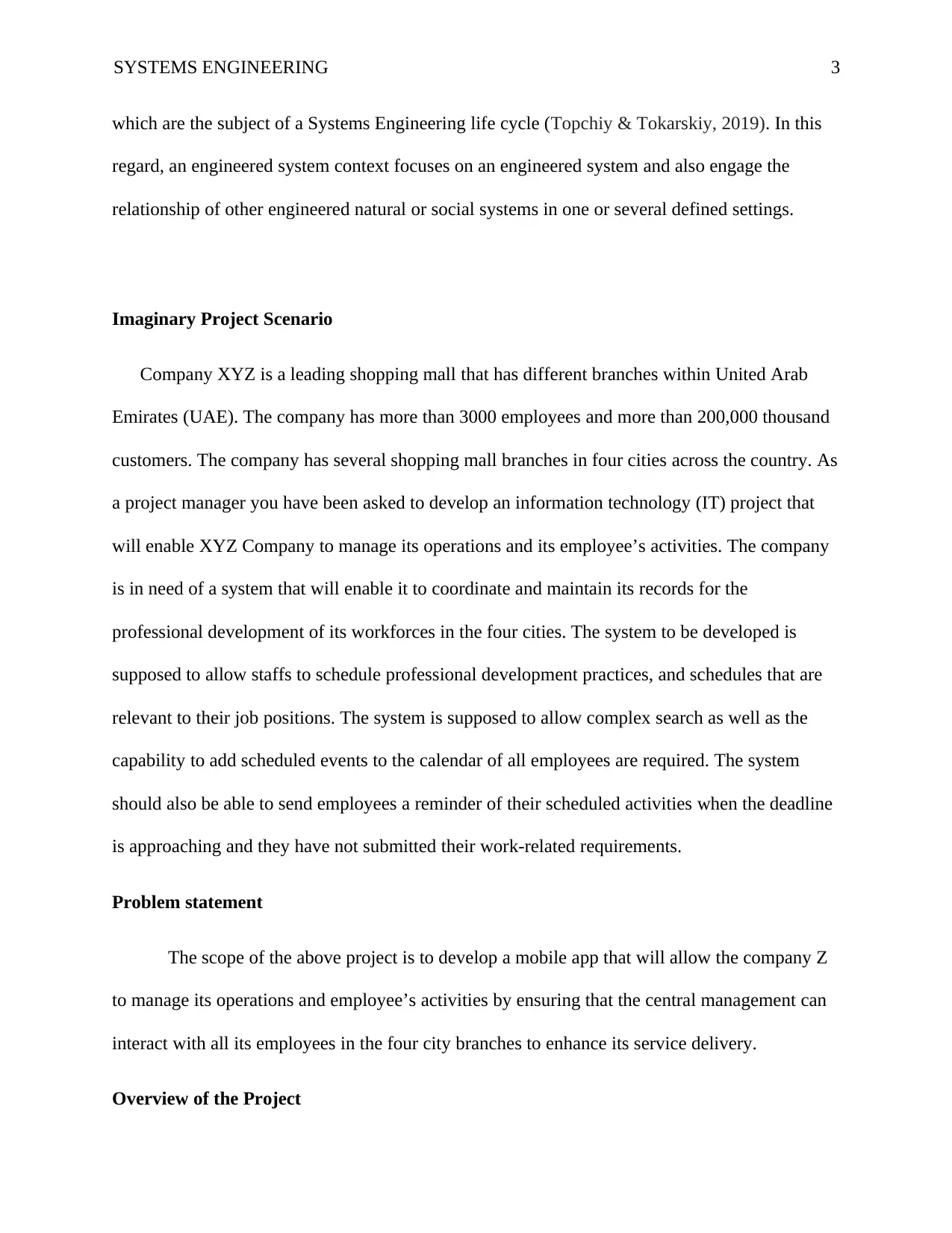
SYSTEMS ENGINEERING 3
which are the subject of a Systems Engineering life cycle (Topchiy & Tokarskiy, 2019). In this
regard, an engineered system context focuses on an engineered system and also engage the
relationship of other engineered natural or social systems in one or several defined settings.
Imaginary Project Scenario
Company XYZ is a leading shopping mall that has different branches within United Arab
Emirates (UAE). The company has more than 3000 employees and more than 200,000 thousand
customers. The company has several shopping mall branches in four cities across the country. As
a project manager you have been asked to develop an information technology (IT) project that
will enable XYZ Company to manage its operations and its employee’s activities. The company
is in need of a system that will enable it to coordinate and maintain its records for the
professional development of its workforces in the four cities. The system to be developed is
supposed to allow staffs to schedule professional development practices, and schedules that are
relevant to their job positions. The system is supposed to allow complex search as well as the
capability to add scheduled events to the calendar of all employees are required. The system
should also be able to send employees a reminder of their scheduled activities when the deadline
is approaching and they have not submitted their work-related requirements.
Problem statement
The scope of the above project is to develop a mobile app that will allow the company Z
to manage its operations and employee’s activities by ensuring that the central management can
interact with all its employees in the four city branches to enhance its service delivery.
Overview of the Project
which are the subject of a Systems Engineering life cycle (Topchiy & Tokarskiy, 2019). In this
regard, an engineered system context focuses on an engineered system and also engage the
relationship of other engineered natural or social systems in one or several defined settings.
Imaginary Project Scenario
Company XYZ is a leading shopping mall that has different branches within United Arab
Emirates (UAE). The company has more than 3000 employees and more than 200,000 thousand
customers. The company has several shopping mall branches in four cities across the country. As
a project manager you have been asked to develop an information technology (IT) project that
will enable XYZ Company to manage its operations and its employee’s activities. The company
is in need of a system that will enable it to coordinate and maintain its records for the
professional development of its workforces in the four cities. The system to be developed is
supposed to allow staffs to schedule professional development practices, and schedules that are
relevant to their job positions. The system is supposed to allow complex search as well as the
capability to add scheduled events to the calendar of all employees are required. The system
should also be able to send employees a reminder of their scheduled activities when the deadline
is approaching and they have not submitted their work-related requirements.
Problem statement
The scope of the above project is to develop a mobile app that will allow the company Z
to manage its operations and employee’s activities by ensuring that the central management can
interact with all its employees in the four city branches to enhance its service delivery.
Overview of the Project
⊘ This is a preview!⊘
Do you want full access?
Subscribe today to unlock all pages.

Trusted by 1+ million students worldwide
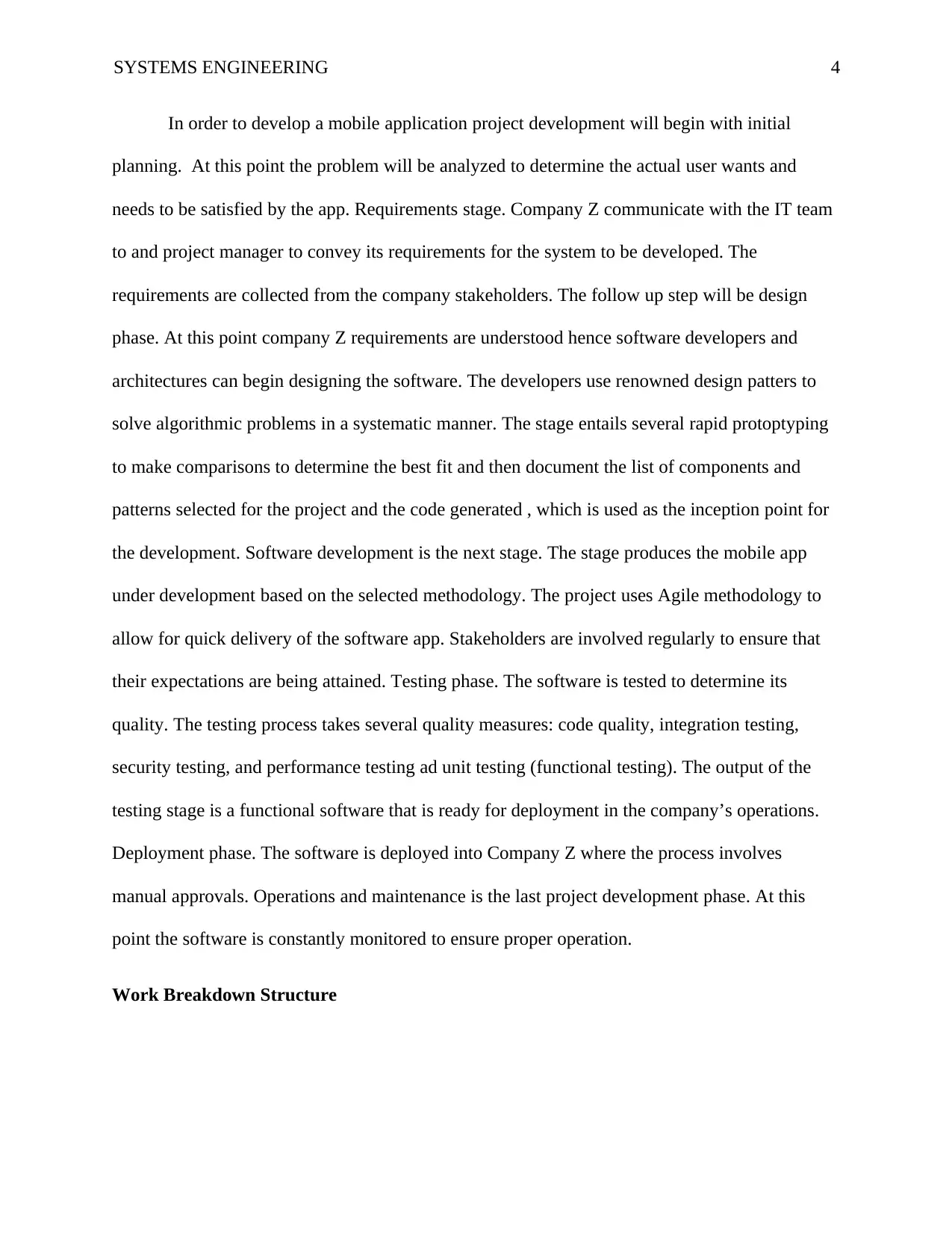
SYSTEMS ENGINEERING 4
In order to develop a mobile application project development will begin with initial
planning. At this point the problem will be analyzed to determine the actual user wants and
needs to be satisfied by the app. Requirements stage. Company Z communicate with the IT team
to and project manager to convey its requirements for the system to be developed. The
requirements are collected from the company stakeholders. The follow up step will be design
phase. At this point company Z requirements are understood hence software developers and
architectures can begin designing the software. The developers use renowned design patters to
solve algorithmic problems in a systematic manner. The stage entails several rapid protoptyping
to make comparisons to determine the best fit and then document the list of components and
patterns selected for the project and the code generated , which is used as the inception point for
the development. Software development is the next stage. The stage produces the mobile app
under development based on the selected methodology. The project uses Agile methodology to
allow for quick delivery of the software app. Stakeholders are involved regularly to ensure that
their expectations are being attained. Testing phase. The software is tested to determine its
quality. The testing process takes several quality measures: code quality, integration testing,
security testing, and performance testing ad unit testing (functional testing). The output of the
testing stage is a functional software that is ready for deployment in the company’s operations.
Deployment phase. The software is deployed into Company Z where the process involves
manual approvals. Operations and maintenance is the last project development phase. At this
point the software is constantly monitored to ensure proper operation.
Work Breakdown Structure
In order to develop a mobile application project development will begin with initial
planning. At this point the problem will be analyzed to determine the actual user wants and
needs to be satisfied by the app. Requirements stage. Company Z communicate with the IT team
to and project manager to convey its requirements for the system to be developed. The
requirements are collected from the company stakeholders. The follow up step will be design
phase. At this point company Z requirements are understood hence software developers and
architectures can begin designing the software. The developers use renowned design patters to
solve algorithmic problems in a systematic manner. The stage entails several rapid protoptyping
to make comparisons to determine the best fit and then document the list of components and
patterns selected for the project and the code generated , which is used as the inception point for
the development. Software development is the next stage. The stage produces the mobile app
under development based on the selected methodology. The project uses Agile methodology to
allow for quick delivery of the software app. Stakeholders are involved regularly to ensure that
their expectations are being attained. Testing phase. The software is tested to determine its
quality. The testing process takes several quality measures: code quality, integration testing,
security testing, and performance testing ad unit testing (functional testing). The output of the
testing stage is a functional software that is ready for deployment in the company’s operations.
Deployment phase. The software is deployed into Company Z where the process involves
manual approvals. Operations and maintenance is the last project development phase. At this
point the software is constantly monitored to ensure proper operation.
Work Breakdown Structure
Paraphrase This Document
Need a fresh take? Get an instant paraphrase of this document with our AI Paraphraser
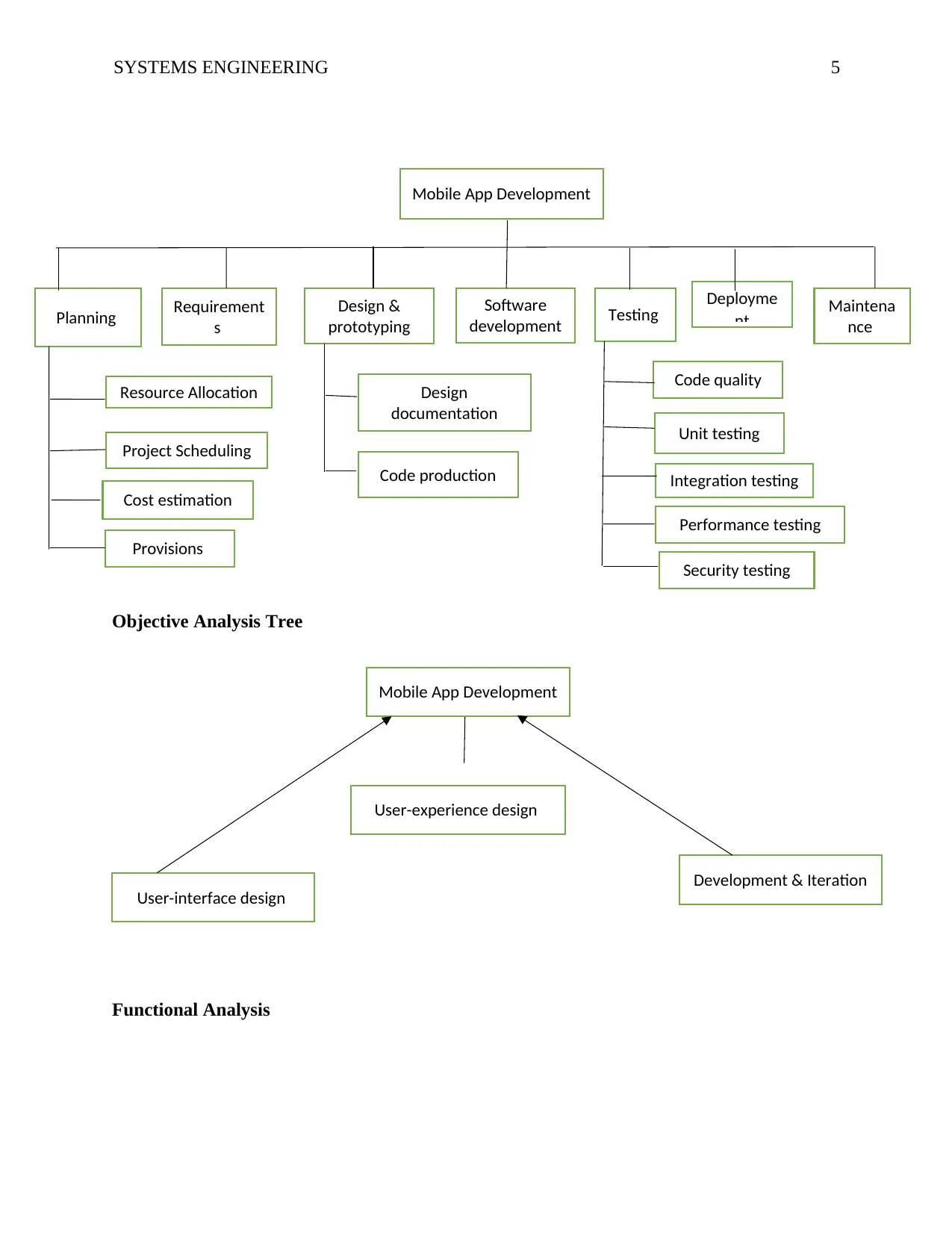
SYSTEMS ENGINEERING 5
Objective Analysis Tree
Functional Analysis
Deployme
nt
Project Scheduling
Planning
Mobile App Development
Requirement
s
Software
development
Design &
prototyping Testing Maintena
nce
Resource Allocation
Cost estimation
Provisions
Design
documentation
Code production
Code quality
Unit testing
Integration testing
Performance testing
Security testing
Mobile App Development
User-experience design
User-interface design
Development & Iteration
Objective Analysis Tree
Functional Analysis
Deployme
nt
Project Scheduling
Planning
Mobile App Development
Requirement
s
Software
development
Design &
prototyping Testing Maintena
nce
Resource Allocation
Cost estimation
Provisions
Design
documentation
Code production
Code quality
Unit testing
Integration testing
Performance testing
Security testing
Mobile App Development
User-experience design
User-interface design
Development & Iteration
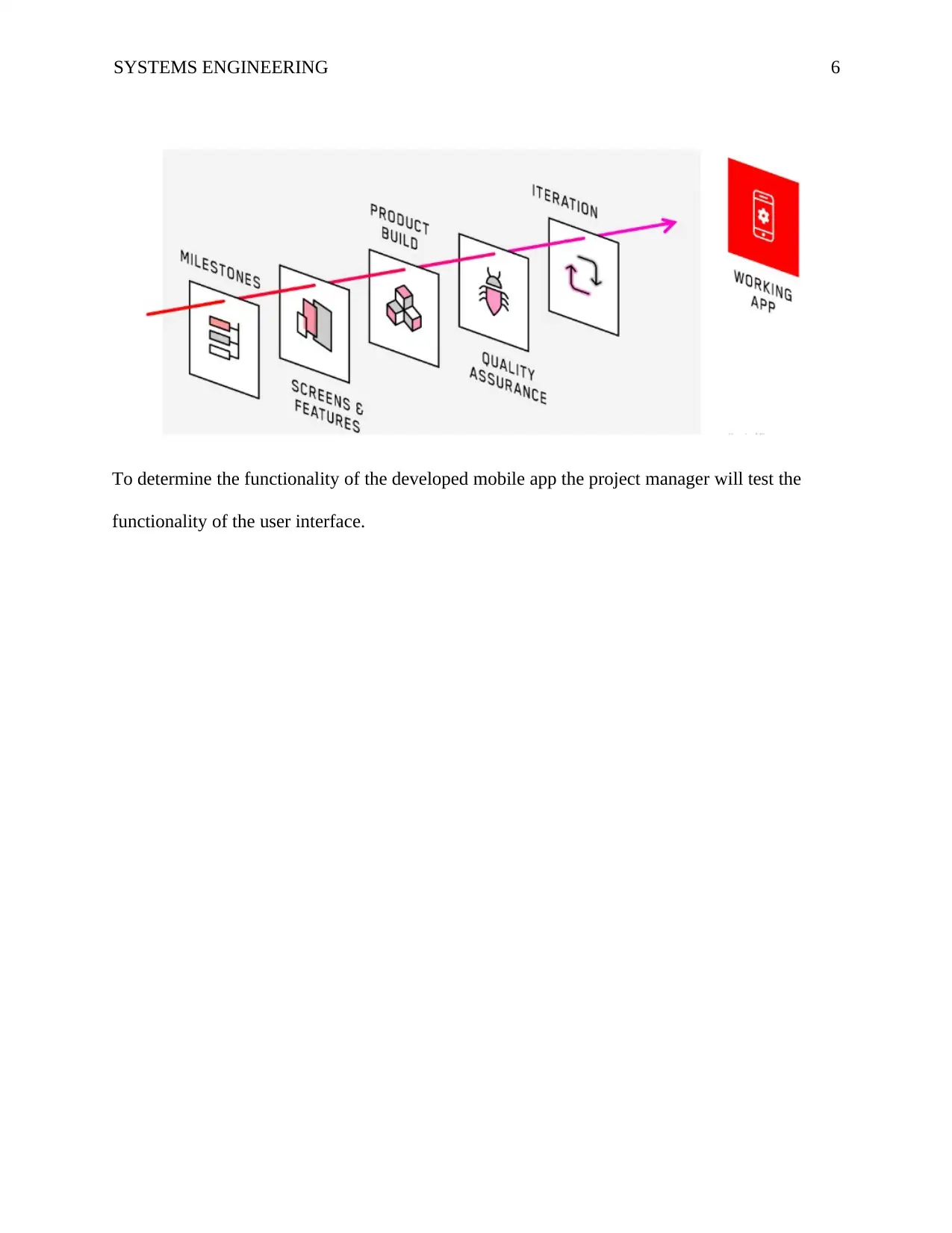
SYSTEMS ENGINEERING 6
To determine the functionality of the developed mobile app the project manager will test the
functionality of the user interface.
To determine the functionality of the developed mobile app the project manager will test the
functionality of the user interface.
⊘ This is a preview!⊘
Do you want full access?
Subscribe today to unlock all pages.

Trusted by 1+ million students worldwide
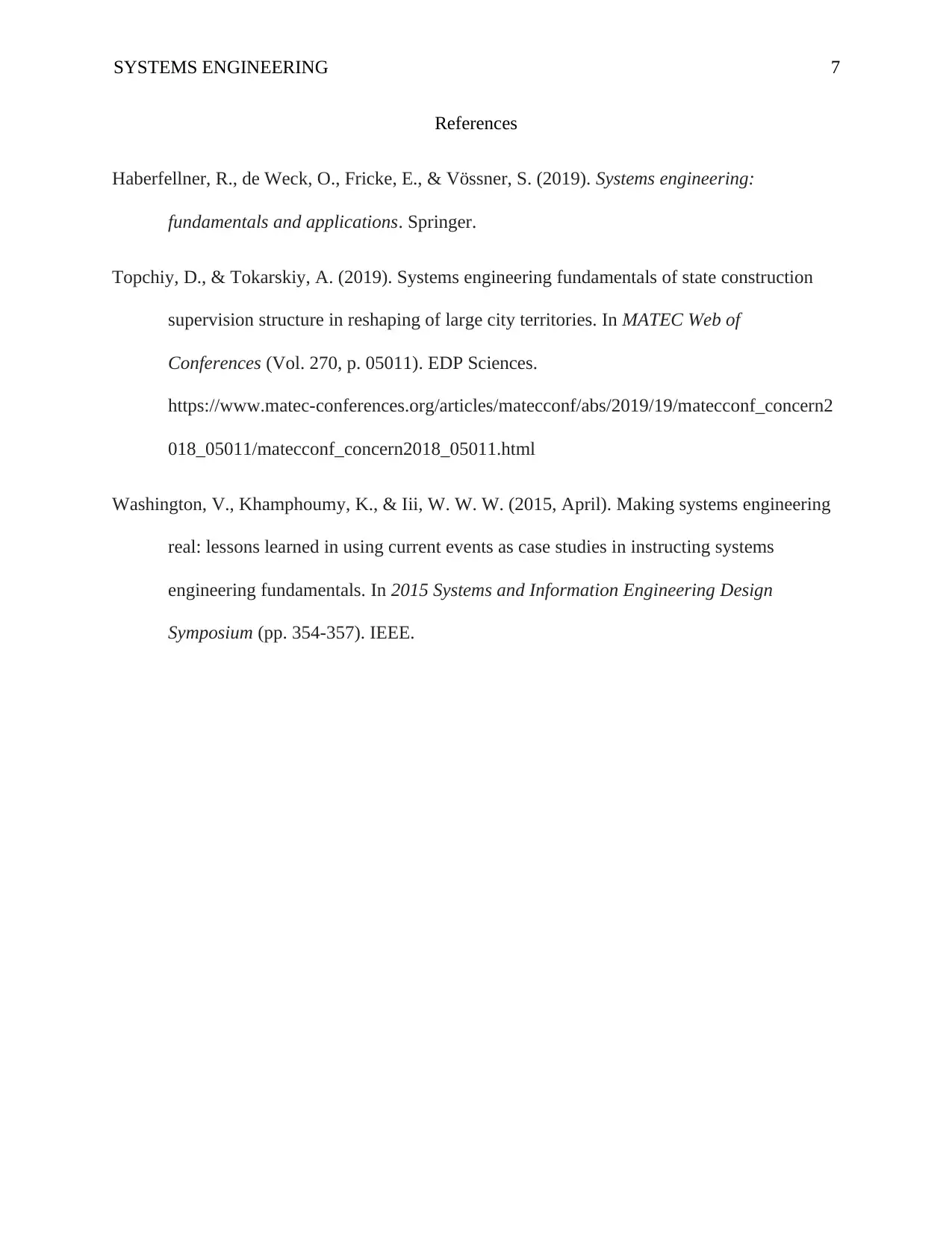
SYSTEMS ENGINEERING 7
References
Haberfellner, R., de Weck, O., Fricke, E., & Vössner, S. (2019). Systems engineering:
fundamentals and applications. Springer.
Topchiy, D., & Tokarskiy, A. (2019). Systems engineering fundamentals of state construction
supervision structure in reshaping of large city territories. In MATEC Web of
Conferences (Vol. 270, p. 05011). EDP Sciences.
https://www.matec-conferences.org/articles/matecconf/abs/2019/19/matecconf_concern2
018_05011/matecconf_concern2018_05011.html
Washington, V., Khamphoumy, K., & Iii, W. W. W. (2015, April). Making systems engineering
real: lessons learned in using current events as case studies in instructing systems
engineering fundamentals. In 2015 Systems and Information Engineering Design
Symposium (pp. 354-357). IEEE.
References
Haberfellner, R., de Weck, O., Fricke, E., & Vössner, S. (2019). Systems engineering:
fundamentals and applications. Springer.
Topchiy, D., & Tokarskiy, A. (2019). Systems engineering fundamentals of state construction
supervision structure in reshaping of large city territories. In MATEC Web of
Conferences (Vol. 270, p. 05011). EDP Sciences.
https://www.matec-conferences.org/articles/matecconf/abs/2019/19/matecconf_concern2
018_05011/matecconf_concern2018_05011.html
Washington, V., Khamphoumy, K., & Iii, W. W. W. (2015, April). Making systems engineering
real: lessons learned in using current events as case studies in instructing systems
engineering fundamentals. In 2015 Systems and Information Engineering Design
Symposium (pp. 354-357). IEEE.
1 out of 7
Related Documents
Your All-in-One AI-Powered Toolkit for Academic Success.
+13062052269
info@desklib.com
Available 24*7 on WhatsApp / Email
![[object Object]](/_next/static/media/star-bottom.7253800d.svg)
Unlock your academic potential
Copyright © 2020–2025 A2Z Services. All Rights Reserved. Developed and managed by ZUCOL.




